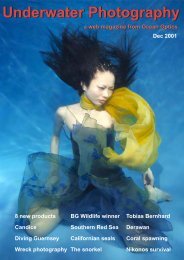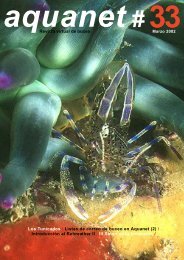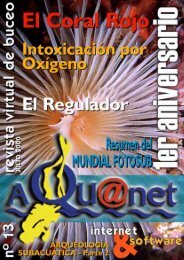Underwater Photography - SENSACIONES.org
Underwater Photography - SENSACIONES.org
Underwater Photography - SENSACIONES.org
Create successful ePaper yourself
Turn your PDF publications into a flip-book with our unique Google optimized e-Paper software.
The final advantage of a DSLR is<br />
undoubtedly the processing power of<br />
the electronics. Most entry level<br />
cameras take time to process an image<br />
once the shutter has been pressed. The<br />
most common image file format is<br />
JPG which compresses the file by<br />
removing unneeded data without<br />
affecting the image quality<br />
significantly. This reduces the time<br />
taken to process a shot but your ability<br />
to manipulate the shot at a later date<br />
will be severely limited.<br />
If you want to have total control<br />
over your image quality you will need<br />
to shoot and save your files in RAW<br />
format. This produces an image which<br />
is unprocessed and has had no data<br />
removed. Naturally these files are<br />
With Compact flash memory<br />
cards available up to 4<br />
gigabytes, this gives you<br />
around 400 RAW format<br />
images.<br />
much bigger than a JPG so an<br />
entry level camera might take<br />
up to 20 seconds to store<br />
them. During this time you<br />
cannot take another picture. A<br />
DSLR camera has the<br />
electronic capacity to save<br />
these larger files and still let<br />
you take more shots. The<br />
number of extra shots you<br />
can take is not limitless unfortunately.<br />
The camera lets you take more shots<br />
because it is using its “buffer”<br />
memory to hold the files whilst they<br />
are being saved to the memory card.<br />
The D100 lets you take around four<br />
images in quick succession then you<br />
won’t be able to take any more shots<br />
for approximately 20 seconds while<br />
the files are saved to disk. In my<br />
experience I have never “overrun” the<br />
buffer but I can imagine times when I<br />
would i.e. humpbacks and sharks<br />
where photo opportunities are limited<br />
to very brief swimpasts.<br />
The ability to fire the motordrive<br />
on a 35mm SLR camera with no<br />
buffer problem is a major advantage<br />
in these situations but that is where<br />
the advantage definitely ends because<br />
you will only have 36 shots. With a<br />
DSLR you can have an almost<br />
limitless number of shots because you<br />
can simply buy a larger capacity<br />
memory card. I believe the maximum<br />
capacity of a Compactflash card is<br />
4gig so if a 1 gig card will hold<br />
approximately 100 images, a 4 gig<br />
will give you up to 400 images!<br />
35mm film users stick that in your<br />
pipe and smoke it.<br />
The DSLR is not, however,<br />
perfect. Entry level cameras are much<br />
lighter, cheaper and less bulky and<br />
they have a nice large LED screen to<br />
view which shows the exact image<br />
you are about to get (shutter delay<br />
permitting). DSLRs on the otherhand<br />
are more expensive and bulkier and<br />
they have traditional flipping mirrors<br />
so you will only see the final image<br />
once you have pressed the shutter. In<br />
practice this is not a big deal as your<br />
image appears almost instantly on the<br />
LCD screen on the back of the<br />
camera.<br />
For underwater use the DSLR<br />
optical viewfinders are not ideal. They<br />
are designed for use on land where<br />
you can get your eye very close to the<br />
viewfinder. <strong>Underwater</strong> with a mask<br />
makes the viewing image much<br />
smaller and makes manual focusing<br />
very tricky but the capability of the<br />
modern autofocus systems makes<br />
manual focusing, certainly for me, a<br />
thing of the past.<br />
Whenever I ‘invest’ in a new<br />
camera system my partner Debbie<br />
always gives me a knowing look<br />
when I try to justify my purchase by<br />
saying “And this system is all I’ll ever<br />
need”. She’s heard it too often<br />
(especially with computers!) but for<br />
once I really do believe that the DSLR<br />
format camera provides all I need now<br />
and for the future.<br />
As a result, I will not be writing<br />
the next article because I’m not<br />
thinking of upgrading to a full size<br />
chipDSLR (FSCDSLR!). The<br />
problem is that I will have to<br />
proofread it and I might start to see<br />
limitations in my DSLR!<br />
Time will tell.<br />
Peter Rowlands<br />
peter@uwpmag.com<br />
50
















